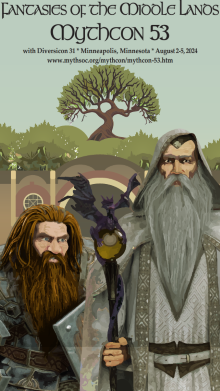Abstract
C.S. Lewis, J.R.R. Tolkien, and Philip Pullman have all written children’s fantasies derived from the medieval Irish immram, or voyage tale, best known from the voyage tales of the Irish figures, Saint Brendan and Mael Duin. William Flint Thrall defined the immram as “a sea-voyage tale in which a hero, accompanied by a few companions, wanders about from island to island, meets Otherworld wonders everywhere, and finally returns to his native land." In Lewis’s The Voyage of the Dawn Treader (1952), Lucy and Edmund Pevensie are joined by their ill-mannered cousin Eustace on a voyage to a number of marvelous islands in the Narnian ocean. In Tolkien’s Roverandom (1998), an ill-mannered puppy named Rover is sent on a voyage to the moon and the Deep Blue Sea. In Pullman’s The Book of Dust, Volume One: La Belle Sauvage (2017), two children, Malcolm and Alice, rescue the baby Lyra from the those who wish to control her. In a wild voyage down the flooded River Thames, they encounter a number of strange islands. But these stories are more than exciting adventure tales. The voyage also serves as a metaphor for the soul’s moral testing. Thomas Owen Clancy describes the immram as “the saving of souls which use a voyage on the sea as the means of redemption.” Eustace is transformed, literally and spiritually, and is redeemed in the course of his voyage. Likewise, Tolkien’s Rover is transformed, literally and spiritually, and is redeemed. It is presumed that Pullman’s Lyra is transformed by drinking fairy-milk (although the effects of this will not be seen until after the events of this novel). It is primarily Malcolm, however, who faces the moral challenges in Pullman's book. Yet, unlike Lewis and Tolkien, who write through a Christian lens, Pullman’s agnostic/atheistic lens is not concerned with spiritual redemption, but, rather, with right action. Malcolm, in his particular circumstances, performs the right action to protect Lyra and Alice, and he is subsequently rewarded with a place at Jordan College, Pullman’s analog of an earthly paradise. All three authors use the medieval immram structure and motifs to tell tales of transformation and personal growth. Lewis and Tolkien maintain the form’s original purpose of depicting Christian redemption stories. Pullman inverts several of the genre’s stock episodes and motifs, and thus subverts the immram’s original purpose, opting instead to depict a story of acting to save lives in the earthly realm.
ORCID ID
https://orcid.org/0000-0001-7637-0719


